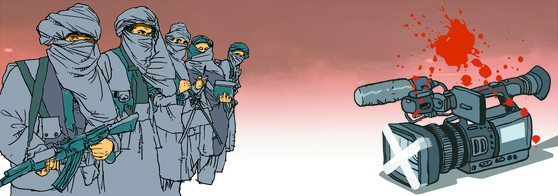The Taliban, press and social media

The author is the head of the international news team of the JoonAng Ilbo.
If the Gulf War gave CNN a spotlight and the war in Afghanistan made Al Jazeera a star, the end of the 20-year-long war in Afghanistan was for social media. Raw footage that news camera failed to capture was posted in real time.
The word tragedy is not enough to describe the Afghans who fell from the wheels of a transport plane leaving a Kabul airport. How about the parents who threw their children over a fence to soldiers? The terror attacks that killed 170 lives right before the U.S. forces withdrawal and consequent retaliation by the U.S. were also broadcast on social media unfiltered.
That was possible thanks to the remarkable “media growth” in Afghanistan in the 20 years of U.S. forces being stationed in the country. It is far short of the developed world’s standard, but 69 percent of the 39 million people in Afghanistan use mobile phones, and 22 percent use the internet. One in ten, about 4.4 million, uses social media. Sixty percent of households have access to television.
TOLOnews, a 24-hour news channel equivalent to CNN in Afghanistan, was founded. Right after the fall of Kabul, a female anchor wearing hijab interviewing a Taliban official made news.
The Taliban surely knows the power of media. Returning with smartphones, the Taliban 2.0 is media-friendly, voluntarily hosting a large-scale press conference the day after occupying Kabul. Shortly after the withdrawal of U.S. forces, it celebrated “Winning complete victory” on Twitter. They are framing the former government as a pro-U.S. puppet and itself as a self-reliant and independent government. With this level of “addiction,” it won’t be easy to completely ban internet and television as it did the first time it held power.
But hundreds of reporters are hiding or have fled since the Taliban has advanced. According to Reporters Without Borders, around 100 media outlets shut down in recent weeks. The female anchor who had interviewed the Taliban reportedly left the country, saying that she was afraid.
In its first news conference, the Taliban assured that the freedom of the press would be guaranteed, but no one believes that. In the meantime, reports of domestic and foreign journalists being attacked and murdered continue.
American think tank Atlantic Council pointed out, “Today’s Taliban understands how to disseminate its propaganda at scale and speed.” Meanwhile, Afghans are trying to expose “the increasingly savage reality of its rule. They say they should not be deceived by the showmanship of displaying a moderate face on television and using smartphones skillfully. What will the Taliban be like after taking power, as it had attacked a broadcasting station for not delivering their “voices of resistance” two decades ago? Media and social media control will reveal its true face.










with the Korea JoongAng Daily
To write comments, please log in to one of the accounts.
Standards Board Policy (0/250자)